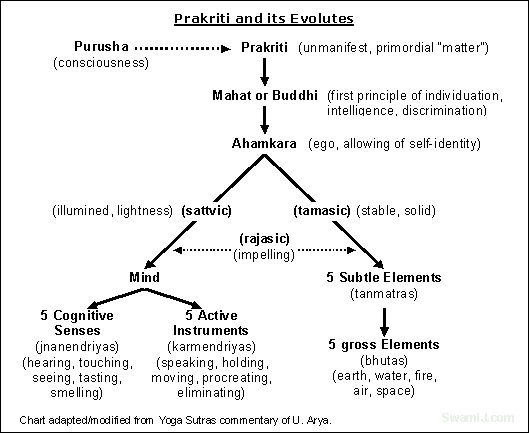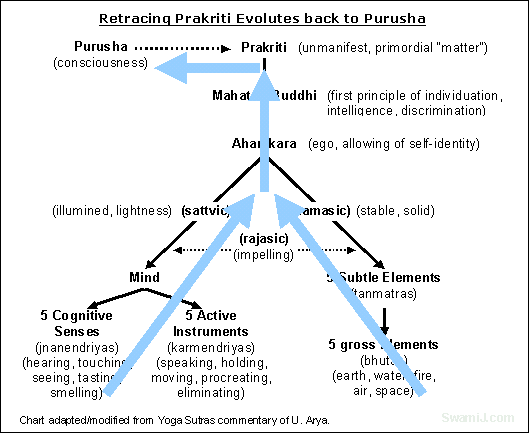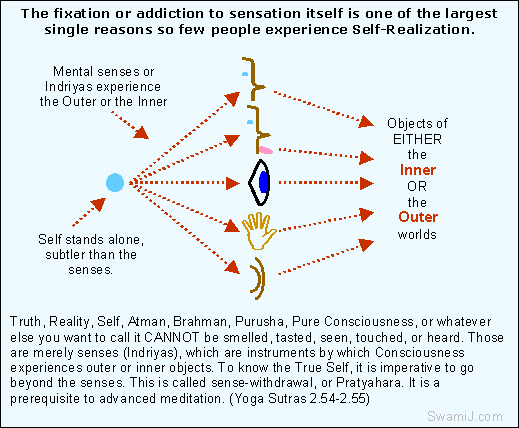Purusha:
Of the two companion principles, Purusha is consciousness that is untainted,
ever-pure. It is self-existent, standing alone from other identities of
individuality; conscious being-ness; the principle of spiritual energy.
Purusha (Spirit) is transcendental and changeless; it
is the Witness of manifestation, of prakriti or maya.
Purusha (Spirit) is Being, Existing, beyond
Creation, and therefore unaffected by it.
Purusha (Spirit) is the cause of the Universe
Purusha (Spirit) activates Prakriti (Nature)
Prakriti:
The other of the two companion principles, Prakriti is the unconscious,
unmanifest, subtlest of the material aspect of energy. It is the primordial
state of matter, even prior to matter as we know it in the physical sense.
Prakriti manifests as the three gunas and the other evolutes.
Prakriti, (Nature, Cosmic Energy, Maya, Creative
Force) is the first Manifestation. It contains all the knowledge of the
Universe.
Ahamkara:
This is the process of ego, by which consciousness can (incorrectly) take on
false identities. The I Ness principle, it believes that perceptions are true.
Atman
or the Self is part of Purusha (Spirit). When it is
involved in the realm of matter, it identifies with it and thinks it is the
personality self.
Once the Atman or Self realizes its oneness with
Purusha (Spirit) the Ego disappears. This is liberation
Purusha (Spirit) is the Universal aspect of the Self
Atman or Self is the self revealing essence in
everyone
To the enlightened person Atman and Purusha are the
same
We
may ask the question, is the world real or unreal?
The world and its manifestation are real when seen
through the perception of the Ego or Ahamkara, but for the realized one, the
world of matter ceases to exist as it merges with Purusha without any
distinction.
Rediscovery
of pure consciousness: The process of Self-realization is
one of reversing the process of manifestation, of retracing consciousness back
through the levels of manifestation to its source. To have a general
understanding of this process is extremely useful.
Senses
experiencing the Elements: Notice below that the Senses and
Instruments of action (Indriyas) emerge out of unmanifest matter, or Prakriti.
Notice that
the five Elements also emerge out of Prakriti. Thus, one set of evolutes
(Senses and Instruments of action) are relating to another set of evolutes (the
five Elements in the form of many objects).
This is one way of explaining the mechanics of how one
can appear to be multiplicity.

Senses
experiencing the Elements: Notice that the Senses and
Instruments of action (Indriyas) emerge out of unmanifest matter, or Prakriti.
Notice that the five Elements also emerge out of Prakriti. Thus, one set of
evolutes (Senses and Instruments of action) are relating to another set of
evolutes (the five Elements in the form of many objects). This is one way of
explaining the mechanics of how it can be that all is one can appear to be
multiplicity.

These descriptions are intended to give a feel for
the inner process, not to be literal, step by step instructions. The specific
practices are the subject of the Yoga Sutras. But this systematic journey gives
a general understanding of the process and supplements what was learned when we
studied the sutras.

Meditation
on I-am-ness: Most of the time we mistakenly think
that "who I am" is my mind and personality. However, as we gradually
come to witness the subtle elements, the senses, and the mind itself, we come
to see that there is a still subtler aspect, which simply declares "I am!" When it stands alone
in this way, it is independent of the other manifestations.
To be aware
of this "I-am-ness" (Ahamkara) is a further stage along the journey
to realization of pure Consciousness (Purusha). This Ahamkara (literally
"I-maker") becomes the coloring agent for attachments and aversions,
which define our personalities and false identities.
In meditation on this subtle level, those have
subsided along with the senses.
Notice, once again, that the process is similar to
dealing with gross objects of meditation, as well as the elements and senses.
Something emerged from something, and now we are simply becoming aware of that
substratum, letting go of the more surface manifestations. (Take a look at the
third level of concentration in Yoga Sutra 1.17, which is on I-ness.
Meditation with Buddhi standing alone: Still subtler
is Buddhi, which is the individuated intelligence itself. It doesn't yet
declare itself to be this or that identity, but is the very intelligence, which
supports the ego (Ahamkara), the senses and instruments of actions (Indriyas),
and the constructs of the inner objects and physical body, the Tanmatras.
One of the final resting places of the individuated
person is to know oneself as Buddhi, this most fine vehicle of consciousness
(Purusha). It is still constructed of Prakriti, leaving that final
discrimination or uncovering yet to be done. To know oneself at this level of
Buddhi is sometimes called the level of bliss or ananda, as all of the other
levels and false identities have temporarily come to rest or been transcended.
Purusha
resting in itself:
Finally Purusha, pure consciousness, rests in
itself, alone, separate from all evolutes of Prakriti. When the aspirant on the
path of Self-realization seeks even a minute moment of this highest glimpse of
Realization, he or she continues to purify the remaining samskaras and karmas.
(See Yoga Sutras 1.3 and 3.56)
Keep it simple: As already said above, these descriptions
are intended to give one a sense of this inner process, but not to be taken as literal,
step by step instructions.
The specific practices are the subject of the Yoga
Sutras. The journey is systematic, and flows much more smoothly by having a
general understanding of the process.
No comments:
Post a Comment